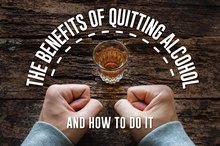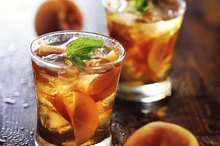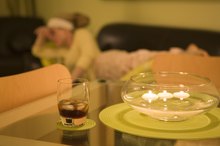Parts of the Brain Affected by Alcohol
According to the U.S. Department of Health and Human Services, 51.6 percent of Americans over the age of 12 reported themselves as alcohol drinkers in 2008. The National Institute of Alcohol Abuse and Alcoholism (NIAAA) has reported what we all know: alcohol causes walking difficulties, slurred speech, blurred vision and adversely affects our reaction times. What parts of the brain is affected by alcohol?
Temporary Effects
Even in small doses, alcohol inhibits the ability of certain parts of the brain to function. Short-term effects of alcohol on the brain include the parts that control cognitive ability, such as attention, judgment, memory, sleep and coordination. These skills are all made possible by the cerebrum, which is part of the forebrain. The cerebrum is the top most part of the brain and is responsible for the ability to think. Furthermore, alcohol affects the hippocampus, which is responsible for long-term memories.
- Even in small doses, alcohol inhibits the ability of certain parts of the brain to function.
- Furthermore, alcohol affects the hippocampus, which is responsible for long-term memories.
Long-Term Effects
Ambien & Liver Problems
Learn More
The cerebellum is an area sensitive to alcohol and may result in permanent damage after chronic consumption of large amounts of alcohol. The cerebellum is the part of the hindbrain, which controls vital bodily functions such as respiration and heart rate. Up to 80 percent of alcoholics (those who are mentally and physically dependent upon alcohol) have thiamine deficiencies, which is particularly important to the cerebellum's function. Thiamine deficiency can cause Wernicke-Korsakoff syndrome (WKS), which is characterized by difficult muscle coordination, mental confusion and memory lapses. This syndrome can be reversed once the deficiency is addressed.
- The cerebellum is an area sensitive to alcohol and may result in permanent damage after chronic consumption of large amounts of alcohol.
- Up to 80 percent of alcoholics (those who are mentally and physically dependent upon alcohol) have thiamine deficiencies, which is particularly important to the cerebellum's function.
Nerve Cell Generation
The brain is comprised of nerve cells that transmit signals to the rest of the body. Most nerve cells are generated when a person is developing from an embryo. However, new nerve cells can be produced in the brain by a process called neurogenesis. Studies on the effect of alcohol in animals showed that alcohol inhibits new nerve cell growth. Thus, the ability of the brain to repair itself is blocked by the effects of alcohol. The inhibiting effects of alcohol on nerve cell generation can explain how a growing fetus may be particularly susceptible, as this is the period of most new nerve growth.
- The brain is comprised of nerve cells that transmit signals to the rest of the body.
- However, new nerve cells can be produced in the brain by a process called neurogenesis.
Related Articles
References
- National Institute on Alcohol Abuse and Alcoholism (NIAAA): Alcohol's Damaging Effects on the Brain
- Alzheimer's Research and Therapy: Alcohol-Related Dementia -- An Update of the Evidence
- International Journal of Environmental Research and Public Health: Ethanol and Cognition -- Indirect Effects, Neurotoxicity and Neuroprotection -- A Review
- Bates, M. E., and Tracy, J. I. (1990). Cognitive Functioning in Young "Social Drinkers": Is There Impairment to Detect? Journal of Abnormal Psychology, 99, 242-249.
- Jensen, G. B., & Pakkenberg, B. (1993). Do Alcoholics Drink Their Neurons Away? The Lancet, 342(8881), 1201-1204.
- National Institute on Alcohol Abuse and Alcoholism. (2004). Alcohol's Damaging Effects on the Brain. Alcohol Alert, 63.
- Nixon, K. and Crews, F. (2004). Temporally Specific Burst in Cell Proliferation Increases Hippocampal Neurogenesis in Protracted Abstinence From Alcohol. The Journal of Neuroscience, 24(43), 9714-9722.
Writer Bio
Leah DiPlacido, a medical writer with more than nine years of biomedical writing experience, received her doctorate in immunology from Yale University. Her work is published in "Journal of Immunology," "Arthritis and Rheumatism" and "Journal of Experimental Medicine." She writes about disease for doctors, scientists and the general public.









